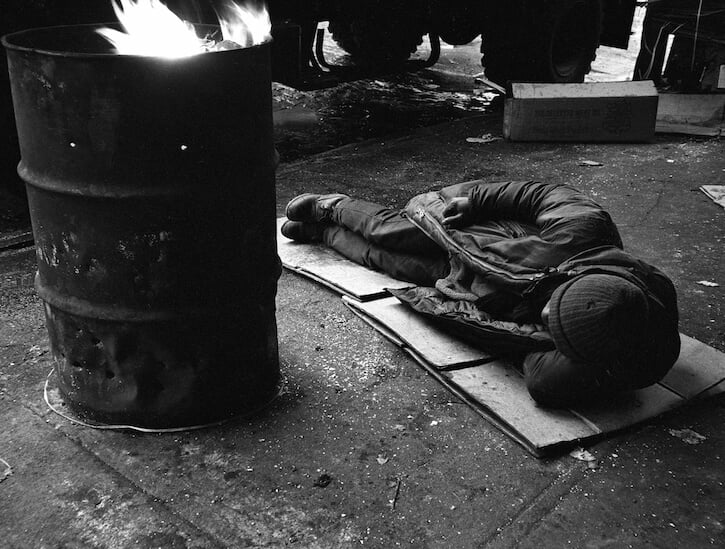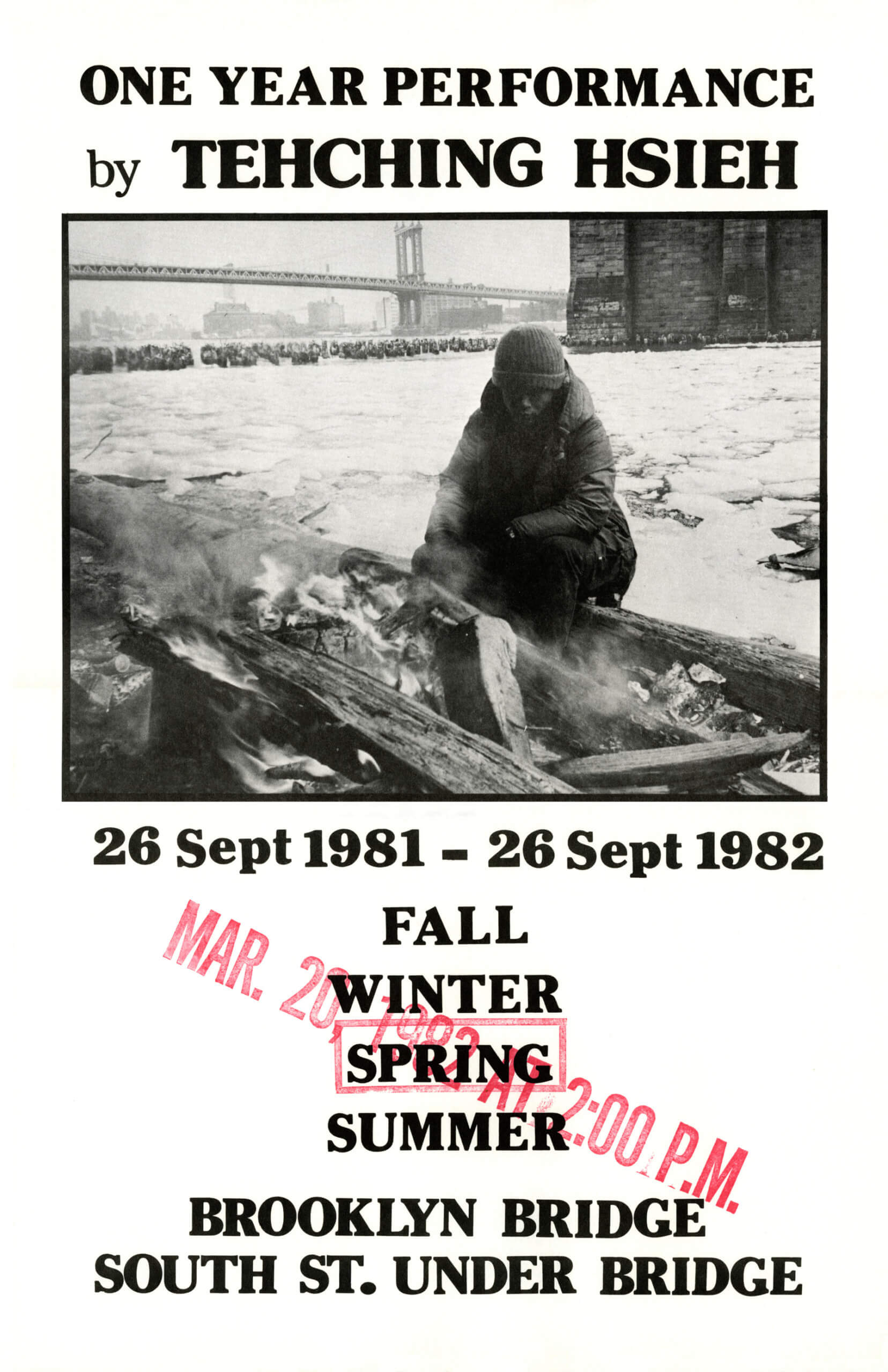Out in the Street

Forty years ago today, the artist Tehching Hsieh was living on the streets of New York City. To New Yorkers who passed him sleeping on a park bench, he would have probably looked like one of the unhoused, whose numbers began rising in the 1980s—collateral damage of Reaganomics, which, far from trickling down wealth, deepened inequality. In fact, Hsieh was in the middle of a durational performance work that he’d begun earlier that fall, for which he vowed to “stay OUTDOORS for one year, never go inside.”
Outdoor Piece, as the work would come to be known, lasted from September 26, 1981 to September 26, 1982. It was the third of five One Year Performances that Hsieh made in the late 1970s and 1980s. These monumental works of endurance—which included locking himself in a cage for a year, and punching a time clock on the hour, also for an entire year—earned him some notoriety in the downtown art scene. It was a scene that, by the time of Outdoor Piece, was on the verge of what Gary Indiana has dubbed the “Wall-Hanging Art Boom spawned by Morning in America.” In 1982, Jean-Michel Basquiat, age twenty-one, created Untitled, a painting of a crowned skull that would later sell for $110.5 million, the highest price ever paid at auction for a work of art by an American. Hsieh stood on the margins of this explosion of glitter and commerce. Recognition from art institutions only came decades later, when the Museum of Modern Art and the Guggenheim Museum exhibited his work.
I admit when I first heard about Outdoor Piece many years ago, my first thought was to wonder where the artist shat. (Answer: he had a number of go-to spots, among them the derelict piers that jutted out from what is now Battery Park City.) I wondered, too, how he managed to stay warm during one of New York City’s coldest recorded winters, when the East River buckled with ice floes. The thing I hardly gave a thought to was his physical safety. By the time I moved to New York City in 2005, the city felt safer than San Francisco, the one I’d left.
The year Hsieh was performing Outdoor Piece, robberies and assaults across the boroughs were at an all-time high.
This changed during the pandemic. Now every time I read a news item about an Asian person shoved to the ground and kicked while walking in Midtown, I think of Hsieh out alone in the streets. Every time I see a headline about an Asian person attacked in Union Square, smashed by a rock while sweeping on the sidewalk, sucker-punched while taking a stroll in brownstone Brooklyn, I recall his performance. It came to mind at the start of the year when Yao Pan Ma, sixty-one, died of injuries sustained from being repeatedly stomped on a street in East Harlem. Having moved to New York City from China a few years earlier, Ma lost his restaurant job during the pandemic; he was gleaning empties to pay for food on the day of the attack. With his slight build and bristle of closely shaved silver hair, he resembled how Hsieh looks now. Or to put it another way, they both look like any number of Asian New Yorkers.
Spurred by misinformation and political scapegoating, incidents of anti-Asian violence spiked by 339 percent from 2020 to 2021, according to a recent study. And that’s only counting the crimes that were reported. Many of my Asian American friends have described being shoved, screamed, and cursed at, even spat on. There have been moments during these past few years when the threat of getting physically assaulted felt more likely than catching the coronavirus, even though I knew this to be statistically false.

Poster for One Year Performance 1981-1982. | Courtesy the artist
A Taiwanese native, Hsieh came to America in 1974 as a seaman. Jumping ship outside Philadelphia, he hailed a cab to New York City, his sights set on making it as an artist in what he believed to be the center of the art world. But he would spend the next four years toiling in low-wage restaurants jobs before conceiving of the first in a series of performance works that would make his name, One Year Performance 1978-1979 (Cage Piece). In interviews, Hsieh has said he wasn’t aware of “performance art” back then. The first time someone mentioned it to him, he thought they were talking about high-performance cars.
The year Hsieh was performing Outdoor Piece, robberies and assaults across the boroughs were at an all-time high. Murders numbered in the thousands, as compared to today’s hundreds. New York magazine’s February 8, 1982, cover story was “Protecting Yourself Against Crime.” The 2014 Oscar Isaac mob film, A Most Violent Year, was set during this period. The city was crawling out from near bankruptcy. Crack cocaine was starting to crest.
1982: The year land artist Agnes Denes cultivated a wheat field along the East River on two acres of landfill excavated from the building of the Twin Towers.
None of this deterred Hsieh from going through with his plan, which says a lot about his fortitude or his madness, depending on which way you look at it. For self-defense, he carried a pair of nunchaku in his rucksack. And yet I know of only one violent attack the artist faced while performing Outdoor Piece—and it ended with his arrest. Here’s what happened: Hsieh was sitting and sipping a cup of tea in a doorway south of Houston Street when the owner of the building emerged wielding a iron rod, yelling at him to leave. An altercation ensued. The cops intervened and hauled Hsieh off to jail, where he was detained for fifteen hours before a sympathetic and bemused judge dropped charges in exchange for time served. (Side note: Possession of nunchaku was a criminal offense in New York until as recently as 2018. The ban was first instituted in the mid-1970s, during the craze for martial arts movies and amid misplaced fears that gang members would incorporate the weapon into their arsenal.)
When I talk to people about Hsieh and describe his performance pieces, I sometimes get asked whether he is, in fact, a real person. This aura of unreality and absurdity is essential to how we fathom, or can’t quite fathom, his work; it’s why the work continues to exert its mysterious grip. Hsieh’s method reflects what the artist Paul Chan has called the “lawless proposition” of art—art that, by “not obeying the law of any system or authority external to the process of its own making,” works by not working at all. That’s certainly one way to describe Hsieh’s One Year Performance 1980-1981 (Time Clock Piece), in which nothing of tangible value is produced in the hour between each of the artist’s increasingly delirious clock-ins. Except art, of course.
Hsieh’s performances strike me as not so much timeless as timeful.
The same year Hsieh was in the streets performing Outdoor Piece, another of his artworks was hanging in an art gallery downtown, part of a group show curated by the late Jeanette Ingberman, who would go on to cofound the nonprofit art space Exit Art. Hsieh’s contribution to the show, titled Wanted by U.S. Immigration Service, was a mock “wanted” poster that featured his own mug shot-style photo alongside identifying physical characteristics. For the first time, Hsieh used his real name publicly. Until then, he’d used a pseudonym, “Sam Hsieh,” to evade arrest and deportation because he was, at that time, undocumented. As with Outdoor Piece, the work draws its gravitational power from Hsieh’s quiet yet defiant foregrounding of his own vulnerability. “You have to make the art stronger than life so people can feel it,” as he once said.
Chan has reflected that an artwork becomes “something more” by ending up where it wasn’t supposed to be. In Hsieh’s case, that “something more” also has to do with an asynchronous quality in his work. By committing to his performances, he removed himself from the grinding rhythms of our daily lives, even as his art compels us to question the returns on our labor. The photographic and video documentation of Outdoor Piece shows us the past—New York of the eighties in all its grit and ragged glory—but so, too, does it seem to be deciphering the future, as Chris Marker said of the startling images the photojournalist Denise Bellon made during the interwar years, of amateur parachuters, sex workers in colonial Tunisia, and disfigured war veterans, among others. Hsieh’s performances strike me as not so much timeless as timeful. The archival images of Hsieh performing Outdoor Piece—sleeping between cars in an uncovered parking lot, warming himself by an open trash can fire at night—remind us, yes, of how exposed he was to the elements but also of the dark forces unleashed by neoliberal policies, such that, forty years later, the work remains capable of speaking to the latest wave of anti-Asian violence, to the crisis of post-pandemic evictions, to the massive shortfall in supportive and affordable housing, to all the hotel rooms sitting vacant while New York City’s mayor orders unhoused encampments to be dismantled.
1982: While Hsieh was making his durational pieces, another performance artist was appearing across town, in the transgressive persona “Mlle Bourgeoise Noire.” Dressed in a floor-length ball gown stitched together from white dinner gloves, Lorraine O’Grady crashed art openings while lashing herself with a cat o’nine tails and calling out, “Now is the time for an invasion!”
Last summer, I went to see the first major retrospective of O’Grady’s work, at the Brooklyn Museum. Now in her late eighties, she, too, is receiving belated recognition. I was moved to read about the supreme care she took in crafting her own press notices, as well as writing critical appraisals of her own work. This was by necessity. For years, among mainstream critical circles, she was an invisible woman. She had to interpret herself to make her work manifest and legible. As the sole keeper of her work and archives, she never wavered from her faith that her “true audience may be coming,” just “not here now.” We are the audience she has been waiting for.
1982: The year the artist Theresa Hak Kyung Cha published her book Dictee, a formally daring masterpiece that alloyed poetry, images, myth, and history to tell the story of a fragmented yet unified self. The year she was raped and strangled by a security guard who left her body in a parking lot in Soho.
Recently, I took part in a virtual self-defense training session, sponsored by the Asian American Federation, offered for free and in English and Mandarin. Spread across the gallery view of my Zoom screen were Asian women of all ages and sizes practicing the blocking techniques we’d all just learned, a different block for each possible angle of attack. There were silver-haired women my mother’s age and professionals with smart haircuts, their jaws clenched. In their backgrounds, I caught glimpses of house plants, Instant Pots, shoji screens, Chinese calligraphy scrolls hanging from walls, dresser tops crowded with cosmetics and creams. I recognized a young author whose debut novel was released earlier this year. Together, we assumed the fighting stance that would help us maintain our center of gravity if someone tried to push or wrestle us to the ground. We chopped the air in front of us in preparation for our future assailants.